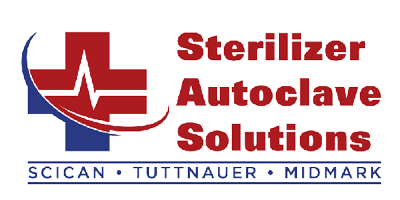What is an Autoclave and How Does It Work? Leave a comment
This article is a revamp of our article, “How Exactly Does an Autoclave Sterilizer Work?” from September 4th, 2018, which you can read here.
Autoclaves are the result of over 150 years of research into disinfection methods. Back in 1679, sterilization by putting steam into a small, enclosed space had just become an idea. But around 1879, Charles Chamberlin had actually constructed the very first autoclave machine for use in the medical field. Since that time the process itself hasn’t really changed. However it has evolved and branched into the many different types of autoclaves we have today. Now there’s not just steam based autoclaves, but ones that have a slew of other new sterilization methods like gravity displacement and vacuum pressure autoclaves.
In this article, we’re going to tell you what autoclaves are, how they work, and a little about each one of the 3 types of autoclaves mentioned above. Having a variety of autoclaves with equally varying sterilization processes is a game changer. Now, there are specific scenarios where one may be able to pick up the slack where another can’t quite manage 100%. And nowadays in the age of the pandemic, the variety is more crucial than ever. Nothing can be left to chance, and when you’ve got machines like these it doesn’t have to be.
And if you just want to talk to someone for any questions you may have, call our Free Tech Support at 704-966-1650 Option 3.
What is an Autoclave?
The dictionary definition of an autoclave is pretty simple; “a strong heated container used for chemical reactions and other processes using high pressures and temperatures, e.g. steam sterilization.” But it’s their uses and benefits that can show you that simple dictionary definition isn’t so cut and dry. They have a very important role in the medical instrument, namely effective sterilization. Keeping any and all instruments as clean as possible from their point of origin to use with patients and staff. One autoclave manufacturer, Tuttnauer, says that smaller businesses like medical and dental facilities will use tabletop autoclaves. Whereas a bigger medical establishment like a hospital will use the much larger models that can clean more instruments in one cycle.
The autoclave itself is a self-contained, pressurized vessel that uses heat to eliminate bacteria, spores, and pathogens on any equipment. They disinfect items wrapped before their first use, or clean an item thoroughly. Even after use in order for it to be safe and patient ready once more.
The most common, but seemingly most trusted and effective method which we’ll explain later is steam sterilization. However, there are other, more recent autoclaves that have different methods that are also effective at bacteria eradication in their own ways. And the need to ensure maximum bacteria removal and also ensuring complete disinfection and safety of a workplace has never been more important than it is now.
How Does an Autoclave Work?
Autoclaves now are found in many different models, with different looks and functions. They work through heat treatment, i.e. heat being delivered by pressurized steam. In fact that is the most common kind of autoclave used, and even according to the CDC Guidelines for Disinfection and Sterilization of Healthcare Facilities which says “Of all the methods available for sterilization, moist heat in the form of saturated steam under pressure is the most widely used and the most dependable.”
But generally what happens in the cycle process starts after everything you need to disinfect is placed into the chamber. The door is auto-locked when it’s closed and sealed airtight creating a vacuum for the cycle. The autoclave will remove all the air in the chamber during the cycle allowing, and subsequently forcing, the steam to penetrate the surface of the material in question. And for complete sterilization, the inside chamber will have to reach a certain temperature range. The temp range for a sterilization cycle stems from 250°F, to 270-275°F to completely kill microorganisms residing on the instruments. This entire process happens in 3 phases throughout its cycle.
Conditioning Phase
This portion of the cycle involves removing the air from the chamber for sterilization. In most types of autoclaves, dynamic air-removal types, it’s a vacuum system that removes the air from the chamber. In other kinds of autoclaves, the air is removed by a series of steam injections and pulses of pressure. Gravity type autoclaves use the density of steam to flush the air out by itself without any other machine help.
Exposure Phase
Once the air is removed, steam is still pumped into the chamber, but the drain closes to keep air out. The continuous steam injections rapidly increase the temperature and pressure throughout the chamber. The interior of the chamber will reach its required temperature limit for that cycle and stay that way until completion. The set times will differ depending on how long the materials need to be at the required temperature for full sterilization.
Exhaust Phase
In this final phase, this step is where the steam is removed from the chamber, and the items are able to dry. The autoclave drain is opened, releasing the steam and pressure from inside the chamber. After the items inside the autoclave dry, then the cycle process is complete.
Each autoclave follows the basic skeleton of the 3 step process during their cycles. However, they all accomplish their tasks in different ways depending on the type of autoclave you have. And we’re going to tell you about each one.
The Different Kinds of Autoclaves
There are 3 main kinds of autoclaves that all have their necessary ways of killing off microorganisms. There are regular and more well-known steam autoclaves, the gravity cycle autoclaves, and the pre/post vacuum cycle autoclaves.
Steam Autoclaves
Steam autoclaves are the more well-rounded ones that have been around since the 1800’s, whereas it’s method of sterilization is as old as the 1600’s. The way these kinds of autoclaves work is by introducing the object in the chamber to direct steam manually. The steam reaches a proper temperature by the time it’s assimilated into the chamber. Those temperatures are in a healthy range of around 250-270ºF at any given cycle time. The required temperature to kill off any pathogens remaining anywhere inside. The increased pressure in the chamber as the cycle continues is the biggest contributing factor in the quickly rising temperature.
These autoclaves were the biggest in the US because we used non-porous materials in medical establishments for so many years. When there were no tiny crevices or anything else to worry about, letting the steam do it’s own thing seemed like a no-brainer. But over time, more and more equipment with a porous surface had turned up and with all of their new intricate functions that made them sought after, that meant that the medical industry had to evolve too. And in the midst of a pandemic where disinfection and sterilization are more important than ever, so came the 2 new popular types of autoclaves.
Gravity Cycle Autoclaves
These kinds of autoclaves are simple, yet interesting for the fact that they rely on gravity during their cycle to force the steam into a porous surface. In fact, its simplicity brought its popularity to the point that the steam autoclave was originally. The autoclave’s ability to displace ambient air within its cycles without any help from any other mechanisms is also what makes them more affordable.
The way that gravity displacement autoclaves work is by pumping steam int0 the chamber to displace all the air. Due to the steam’s density, it’s . With all of the air out, the steam has direct contact with the items inside and allowing for thorough sterilization. After the cycle, steam is released through a drain vent, its work doesn’t stop there. The load inside the chamber can still be wet, so some gravity-induced autoclaves are equipped with a post-cycle vacuum. If equipped with said vacuum, this phase will run a regular gravity cycle, and instead start to vacuum the steam through the air vent and any moisture or condensation left over. The vacuum will make the load cooler and dryer once the cycle finishes.
Pre/Post-Vacuum Autoclaves
This last autoclave type, the pre/post vacuum, is the second most popular type around today tied with the gravity cycle autoclaves for good reason. Unlike the other 2 types mentioned previously, the pre/post vacuum autoclave is the most effective when sterilizing porous instruments and materials, or open vented items like cages. The vacuum system inside the autoclave allows the steam to more easily penetrate the more intricate areas or more open areas of any instruments within the chamber.
The way it works is through rapid steam injection and vacuum drawn pulses during its cycle. This process of alternating between steam and vacuum will continue to remove the ambient air from the chamber. The air gets removed, but the vacuum draws the steam into the harder to penetrate areas of the load. And this process happens near instantaneously, which makes the cycles significantly shorter, but just as effective.
Now, the post-vacuum cycle is for when the sterilization is complete. It’s a process that increases the drying time of the load, essentially like the vacuum attachment for a gravity cycle.
Final Thoughts
It’s no question that we like to be as informative as possible. And with everything that had changed since our previous article we knew it was time for an update. Steam sterilizing autoclaves used to be a one and done deal. Over time that has evolved and it’s how the steam is applied to the cycle that’s changed for the better. Gravity cycle autoclaves have shown how ambient air can be pushed out using steam’s density for maximum efficiency. And vacuum autoclaves show the cycle of taking in and vacuuming out steam that penetrates the most intricately placed crevices.
We hope that this article was able to provide you with an ample amount of information. Keeping up to date on the world of sterilization technology has always been important. And with the world in the midst of a major pandemic, this information is needed now more than ever. Safety is at the front of minds across the globe, and in the medical fields the cleanliness of the instruments you use are at the top of the importance list. Be sure to read and study as much as you can for yours and your patients safety. Your knowledge is very important to us and we will continue to share all we find to help spread the word about safe operations and practices. We will continue to share all we find so when talking about the safety of patients and staff, we know you’ll be more knowledgeable and informed.
As always if you have any questions about this process or anything else please feel free to contact us and take advantage of our “FREE TECH SUPPORT.”
We also offer FREE VIRTUAL TECH SUPPORT to “See and Talk” with a “Real Time Live Technician” for any problems you may be in need of help with.
You can also use our “FREE MAINTENANCE PROGRAM”. Take the guesswork and worrying about what unit is due for maintenance and which maintenance cycle it is time for. We will keep track of all your autoclaves and let you know when it’s time for anything.


